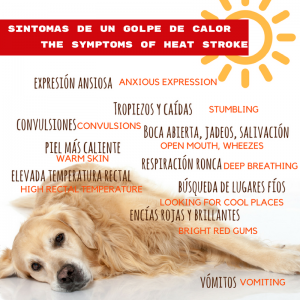Puede contactar con nosotros en: 952 45 12 42 - Urgencias: 654 029 187
Heat-Stroke
Categoría:
Advices
In the area we live,the months of July and August always have the highest temperatures. It is very important to be alert with our pets to avoid heat-stroke. It can be seen as something rather unimportant but, on the contrary, it is very serious and can lead to the death of an animal due to multi-organ failure.
WHAT IS HEAT-STROKE?
It is what happens when a dog cannot expulse more heat than it generates; the body temperature overheats affecting the nervous system. Unlike people, dogs don’t sweat, they pant a lot, making temperature self-regulation difficult. For this reason they are much more prone to heat-stroke than humans.
PREVENTION IS BETTER THAN CURE–this applies to many things in life including heat-stroke. To avoid animals suffering in high temperatures, we must think about the following recommendations:
1. NEVER leave a dog inside a closed car, the inside temperature can rise at an alarming rate.
2. Animals that live outside must have a shady area for protection from the sun during the hottest part of the day.
3. Avoid walks during the warmest hours ie. 1.00-6.00pm. The best time is early morning or late evening and always take water to keep the dog hydrated.
SYMPTOMS.
If a dog is suffering from heat-stroke we can tell from the following symptoms:
Breathing difficulties and constant panting
Lack of strength and not wanting to walk
Blue tinges in the skin due to lack of oxygen in the blood
Cramps or muscular trembling
Dizziness
Vomiting
Loss of consciousness(possibly because the dog is in a coma)
WHAT TO DO IN A CASE OF HEAT-STROKE.
The first thing to do is try and lower the pet’s temperature as soon as possible. Look for a shady area, offer water and cool the animal little by little especially in the groin and armpit area and the neck. A bath in cold water is NOT advisable because the animal could go into shock. Once you have managed to stabilize your pet, contact your vet for advice and to see if a trip to the clinic is necessary.
Leave a Reply
You must be logged in to post a comment.






Comentarios:
0